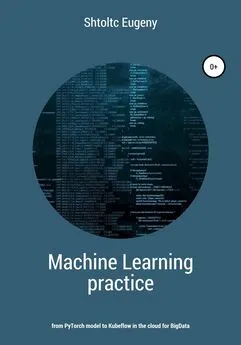Eugeny Shtoltc - IT Cloud
- Название:IT Cloud
- Автор:
- Жанр:
- Издательство:неизвестно
- Год:2021
- ISBN:нет данных
- Рейтинг:
- Избранное:Добавить в избранное
-
Отзывы:
-
Ваша оценка:
Eugeny Shtoltc - IT Cloud краткое содержание
IT Cloud - читать онлайн бесплатно ознакомительный отрывок
Интервал:
Закладка:
essh @ kubernetes-master: ~ / node-cluster $ gcloud container images list
NAME
gcr.io/node-cluster-243923/nodejs_cluster
Only listing images in gcr.io/node-cluster-243923. Use –repository to list images in other repositories.
Now we can see it in the GCP admin panel: Container Registry -> Images. Let's replace the code of our container with the code with our image. If for production it is necessary to version the launched image in order to avoid their automatic update during system re-creation of PODs, for example, when transferring POD from one node to another when taking a machine with our node for maintenance. For development, it is better to use the latest tag , which will update the service when the image is updated. When you update the service, you need to recreate it, that is, delete and recreate it, since otherwise the terraform will simply update the parameters, and not recreate the container with the new image. Also, if we update the image and mark the service as modified with the command ./terraform taint $ {NAME_SERVICE} , our service will simply be updated, which can be seen with the command ./terraform plan . Therefore, to update, for now, you need to use the commands ./terraform destroy -target = $ {NAME_SERVICE} and ./terraform apply , and the name of the services can be found in ./terraform state list :
essh @ kubernetes-master: ~ / node-cluster $ ./terraform state list
data.google_client_config.default
module.kubernetes.google_container_cluster.node-ks
module.kubernetes.google_container_node_pool.node-ks-pool
module.Nginx.kubernetes_deployment.nodejs
module.Nginx.kubernetes_service.nodejs
essh @ kubernetes-master: ~ / node-cluster $ ./terraform destroy -target = module.nodejs.kubernetes_deployment.nodejs
essh @ kubernetes-master: ~ / node-cluster $ ./terraform apply
Now let's replace the code of our container:
container {
image = "gcr.io/node-cluster-243923/nodejs_cluster:latest"
name = "node-js"
}
Let's check the result of balancing for different nodes (no line break at the end of the output):
essh @ kubernetes-master: ~ / node-cluster $ curl http://35.246.85.138:80
Nodejs_cluster is working! My host is terraform-nodejs-997fd5c9c-lqg48essh @ kubernetes-master: ~ / node-cluster $ curl http://35.246.85.138:80
Nodejs_cluster is working! My host is terraform-nodejs-997fd5c9c-lhgsnessh @ kubernetes-master: ~ / node-cluster $ curl http://35.246.85.138:80
Nodejs_cluster is working! My host is terraform-nodejs-997fd5c9c-lhgsnessh @ kubernetes-master: ~ / node-cluster $ curl http://35.246.85.138:80
Nodejs_cluster is working! My host is terraform-nodejs-997fd5c9c-lhgsnessh @ kubernetes-master: ~ / node-cluster $ curl http://35.246.85.138:80
Nodejs_cluster is working! My host is terraform-nodejs-997fd5c9c-lhgsnessh @ kubernetes-master: ~ / node-cluster $ curl http://35.246.85.138:80
Nodejs_cluster is working! My host is terraform-nodejs-997fd5c9c-lhgsnessh @ kubernetes-master: ~ / node-cluster $ curl http://35.246.85.138:80
Nodejs_cluster is working! My host is terraform-nodejs-997fd5c9c-lqg48essh @ kubernetes-master: ~ / node-cluster $ curl http://35.246.85.138:80
Nodejs_cluster is working! My host is terraform-nodejs-997fd5c9c-lhgsnessh @ kubernetes-master: ~ / node-cluster $ curl http://35.246.85.138:80
Nodejs_cluster is working! My host is terraform-nodejs-997fd5c9c-lhgsnessh @ kubernetes-master: ~ / node-cluster $ curl http://35.246.85.138:80
Nodejs_cluster is working! My host is terraform-nodejs-997fd5c9c-lhgsnessh @ kubernetes-master: ~ / node-cluster $ curl http://35.246.85.138:80
Nodejs_cluster is working! My host is terraform-nodejs-997fd5c9c-lqg48essh @ kubernetes-master: ~ / node-cluster $
We will automate the process of creating images, for this we will use the Google Cloud Build service (free for 5 users and traffic up to 50GB) to create a new image when creating a new version (tag) in the Cloud Source Repositories repository (free on Google Cloud Platform Free Tier). Google Cloud Platform -> Menu -> Tools -> Cloud Build -> Triggers -> Enable Cloud Build API -> Get Started -> Create a repository that will be available on Google Cloud Platform -> Menu -> Tools -> Source Code Repositories (Cloud Source Repositories):
essh @ kubernetes-master: ~ / node-cluster $ cd app /
essh @ kubernetes-master: ~ / node-cluster / app $ ls
server.js
essh @ kubernetes-master: ~ / node-cluster / app $ mv ./server.js ../
essh @ kubernetes-master: ~ / node-cluster / app $ gcloud source repos clone nodejs –project = node-cluster-243923
Cloning into '/ home / essh / node-cluster / app / nodejs' …
warning: You appear to have cloned an empty repository.
Project [node-cluster-243923] repository [nodejs] was cloned to [/ home / essh / node-cluster / app / nodejs].
essh @ kubernetes-master: ~ / node-cluster / app $ ls -a
… .. nodejs
essh @ kubernetes-master: ~ / node-cluster / app $ ls nodejs /
essh @ kubernetes-master: ~ / node-cluster / app $ ls -a nodejs /
… .. .git
essh @ kubernetes-master: ~ / node-cluster / app $ cd nodejs /
essh @ kubernetes-master: ~ / node-cluster / app / nodejs $ mv ../../server.js.
essh @ kubernetes-master: ~ / node-cluster / app / nodejs $ git add server.js
essh @ kubernetes-master: ~ / node-cluster / app / nodejs $ git commit -m 'test server'
[master (root-commit) 46dd957] test server
1 file changed, 7 insertions (+)
create mode 100644 server.js
essh @ kubernetes-master: ~ / node-cluster / app / nodejs $ git push -u origin master
Counting objects: 3, done.
Delta compression using up to 8 threads.
Compressing objects: 100% (2/2), done.
Writing objects: 100% (3/3), 408 bytes | 408.00 KiB / s, done.
Total 3 (delta 0), reused 0 (delta 0)
To https://source.developers.google.com/p/node-cluster-243923/r/nodejs
* [new branch] master -> master
Branch 'master' set up to track remote branch 'master' from 'origin'.
Now it's time to set up image creation when creating a new version of the product: go to GCP -> Cloud Build -> triggers -> Create trigger -> Google Cloud source code repository -> NodeJS. Trigger tag type so that the image is not created during normal commits. I will change the name of the image from gcr.io/node-cluster-243923/NodeJS:$SHORT_SHA to gcr.io/node-cluster-243923/NodeJS:$SHORT_SHA and the timeout to 60 seconds. Now I'll commit and add a tag:
essh @ kubernetes-master: ~ / node-cluster / app / nodejs $ cp ../../Dockerfile.
essh @ kubernetes-master: ~ / node-cluster / app / nodejs $ git add Dockerfile
essh @ kubernetes-master: ~ / node-cluster / app / nodejs $ git add Dockerfile
essh @ kubernetes-master: ~ / node-cluster / app / nodejs $ cp ../../Dockerfile.
essh @ kubernetes-master: ~ / node-cluster / app / nodejs $ git add Dockerfile
essh @ kubernetes-master: ~ / node-cluster / app / nodejs $ git commit -m 'add Dockerfile'
essh @ kubernetes-master: ~ / node-cluster / app / nodejs $ git remote -v
origin https://source.developers.google.com/p/node-cluster-243923/r/nodejs (fetch)
origin https://source.developers.google.com/p/node-cluster-243923/r/nodejs (push)
essh @ kubernetes-master: ~ / node-cluster / app / nodejs $ git push origin master
Counting objects: 3, done.
Delta compression using up to 8 threads.
Compressing objects: 100% (3/3), done.
Writing objects: 100% (3/3), 380 bytes | 380.00 KiB / s, done.
Total 3 (delta 0), reused 0 (delta 0)
To https://source.developers.google.com/p/node-cluster-243923/r/nodejs
46dd957..b86c01d master -> master
essh @ kubernetes-master: ~ / node-cluster / app / nodejs $ git tag
essh @ kubernetes-master: ~ / node-cluster / app / nodejs $ git tag -a v0.0.1 -m 'test to run'
essh @ kubernetes-master: ~ / node-cluster / app / nodejs $ git push origin v0.0.1
Counting objects: 1, done.
Writing objects: 100% (1/1), 161 bytes | 161.00 KiB / s, done.
Total 1 (delta 0), reused 0 (delta 0)
To https://source.developers.google.com/p/node-cluster-243923/r/nodejs
* [new tag] v0.0.1 -> v0.0.1
Now, if we press the start trigger button, we will see the image in the Container Registry with our tag:
essh @ kubernetes-master: ~ / node-cluster / app / nodejs $ gcloud container images list
NAME
gcr.io/node-cluster-243923/nodejs
gcr.io/node-cluster-243923/nodejs_cluster
Only listing images in gcr.io/node-cluster-243923. Use –repository to list images in other repositories.
Now if we just add the changes and the tag, the image will be created automatically:
essh @ kubernetes-master: ~ / node-cluster / app / nodejs $ sed -i 's / HOSTNAME \} / HOSTNAME \} \ n /' server.js
essh @ kubernetes-master: ~ / node-cluster / app / nodejs $ git add server.js
essh @ kubernetes-master: ~ / node-cluster / app / nodejs $ git commit -m 'fix'
[master 230d67e] fix
1 file changed, 2 insertions (+), 1 deletion (-)
essh @ kubernetes-master: ~ / node-cluster / app / nodejs $ git push origin master
Counting objects: 3, done.
Delta compression using up to 8 threads.
Compressing objects: 100% (3/3), done.
Writing objects: 100% (3/3), 304 bytes | 304.00 KiB / s, done.
Total 3 (delta 1), reused 0 (delta 0)
remote: Resolving deltas: 100% (1/1)
To https://source.developers.google.com/p/node-cluster-243923/r/nodejs
b86c01d..230d67e master -> master
essh @ kubernetes-master: ~ / node-cluster / app / nodejs $ git tag -a v0.0.2 -m 'fix'
essh @ kubernetes-master: ~ / node-cluster / app / nodejs $ git push origin v0.0.2
Counting objects: 1, done.
Writing objects: 100% (1/1), 158 bytes | 158.00 KiB / s, done.
Total 1 (delta 0), reused 0 (delta 0)
To https://source.developers.google.com/p/node-cluster-243923/r/nodejs
* [new tag] v0.0.2 -> v0.0.2
essh @ kubernetes-master: ~ / node-cluster / app / nodejs $ sleep 60
essh @ kubernetes-master: ~ / node-cluster / app / nodejs $ gcloud builds list
ID CREATE_TIME DURATION SOURCE IMAGES STATUS
2b024d7e-87a9-4d2a-980b-4e7c108c5fad 2019-06-22T17: 13: 14 + 00: 00 28S nodejs@v0.0.2 gcr.io/node-cluster-243923/nodejs:v0.0.2 SUCCESS
6b4ae6ff-2f4a-481b-9f4e-219fafb5d572 2019-06-22T16: 57: 11 + 00: 00 29S nodejs@v0.0.1 gcr.io/node-cluster-243923/nodejs:v0.0.1 SUCCESS
e50df082-31a4-463b-abb2-d0f72fbf62cb 2019-06-22T16: 56: 48 + 00: 00 29S nodejs@v0.0.1 gcr.io/node-cluster-243923/nodejs:v0.0.1 SUCCESS
essh @ kubernetes-master: ~ / node-cluster / app / nodejs $ git tag -a latest -m 'fix'
essh @ kubernetes-master: ~ / node-cluster / app / nodejs $ git push origin latest
Counting objects: 1, done.
Writing objects: 100% (1/1), 156 bytes | 156.00 KiB / s, done.
Total 1 (delta 0), reused 0 (delta 0)
To https://source.developers.google.com/p/node-cluster-243923/r/nodejs
* [new tag] latest -> latest
essh @ kubernetes-master: ~ / node-cluster / app / nodejs $ cd ../ ..
Creating multiple environments with Terraform clusters
When trying to create several clusters from the same configuration, we will encounter duplicate identifiers that must be unique, so we isolate them from each other by creating and placing them in different projects. To manually create a project, go to GCP -> Products -> IAM and administration -> Resource management and create a NodeJS-prod project and switch to the project, wait for its activation. Let's look at the state of the current project:
essh @ kubernetes-master: ~ / node-cluster $ cat main.tf
Читать дальшеИнтервал:
Закладка:










